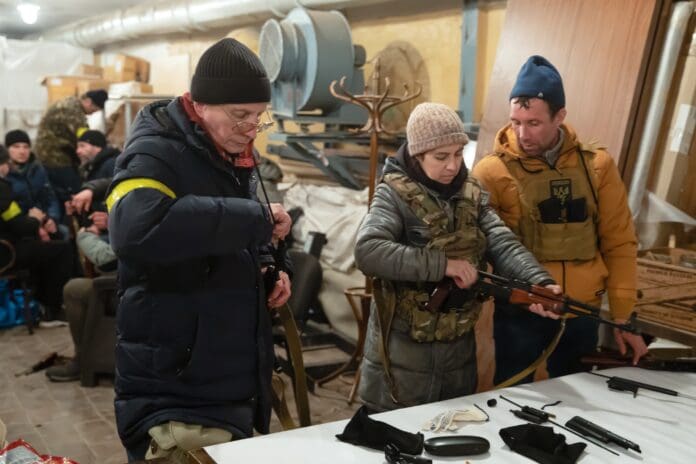
A video from the last day of 2023 at the Task & Purpose YouTube channel gives a pretty good summary of the kinds of war our world saw in 2023. Not only does it show us the potential use Americans might have for the right to keep and bear arms in the United States, but also shows us how dangerous it can be for people who have had that right infringed. (article continues after video)
One important fact he shows in the beginning is that there was more armed conflict in 2023 than in previous years, ending what had been a trend of less conflict. So, warfare is on the rise. It’s also important to keep in mind how far-flung conflicts can be connected in unobvious ways, meaning that things happening next door and even in the United States can be affected by some of these seemingly irrelevant conflicts abroad.
He starts with Syria, giving a history of the conflict there since 2011. What started as protests and mild revolt became a full-scale civil war, which in turn became a proxy war between different big countries. Bashar Al-Assad managed to get most of the country back, and is now influential globally again. This has led to sanctions against Syria backfiring, and turning the economy into a narco-state that exports illegal drugs to neighbors and globally to stay afloat.
In other words, Syria went from being an oppressive regime to a failed state to being run by a drug cartel. This lends a lot of credibility to the argument that authoritarian regimes are basically all turning into a business alliance instead of ideological partners.
But hey, at least ISIS and Al Qaeda have been largely minimized for now, so it’s not all a loss.
This brings us to Mexico. Obviously, there are some serious parallels and connections between what’s happening in Mexico and Syria, given the control cartels have. While some places are better than they were the last time cartels warred, the overall situation is deteriorating. As many as 30,000 Mexicans have been killed in the fighting every year since 2018.
But, the cartels are starting to become a smaller problem than the Mexican government, which is becoming very authoritarian and repressive in its attempt to regain control of the country. So, facing this double squeeze of violence and authoritarianism, many people want out, and this is helping to drive a border crisis with the United States that we’ve all been seeing in the news. In 2023 alone, 2.5 million migrants were seen crossing the border (a new historic high).
Sadly, this influx of people who are just looking for a better existence has made it much harder to keep the bad people who shouldn’t be in the United States out, which directly affects us here at home, even in places far from the border. This leads to serious discussion over whether the U.S. should step in to stop the dual crisis of criminal violence and an increasingly militant government in Mexico, which is all tainted by corruption.
Not far from Florida, Haiti is another warfare hotspot. Like Mexico, Haitians are fleeing to the United States (often through Mexico) to avoid violence after the country’s president was assassinated and the whole place descended into chaos. A multi-national security force led by Kenya and the UN are now authorized to shoot to kill in the country as needed.
Somalia, as it has been for a long time, is also in chaos. But, given the country’s long coastline and key strategic location, the United States and China are now competing for influence there. Weapons smuggled from Iran to Yemen’s Houthi rebels passes through the area, sometimes landing in Somalia, and those weapons are now being used against the U.S. Navy in a conflict that’s connected to fighting in Israel (another place where gun rights are proving vital).
Later in the video, he gets into Afghanistan, which is already becoming a major home to terror groups in the world following the United States disastrous pullout. But, the Taliban and ISIS aren’t getting along, and ironically the Taliban are using U.S. equipment to fight an insurgency.
Another hotspot is Myanmar (aka Burma). As we’ve discussed previously, the conflict there has been heavily influenced by 3D-printed guns (a trend that has only accelerated), so it’s a good indicator of what gun rights can do. Now, the conflict is sucking China in, and they’ve started backing the rebels instead of the military junta, largely because it better supports Chinese interests now.
So, it could be argued that JStark1809 (the now deceased inventor of the FGC-9) played a key role in preserving democracy in the country. This flies in the face of the assertions the Bloomberg-funded Johns Hopkins gun control front made.
So, there’s no doubt that access to arms is a key ingredient in freedom. From Mexico (where guns are denied) to Israel (where guns are coming back) to Myanmar, the proof is in the pudding.




And the temporary (over the last few weeks) rise in weather events makes gun ownership more precious than ever: good luck getting a timely law enforcement response to a violent crime during or after a tornado, flood, blizzard, or hurricane.
Uncommon, you are correct. Me and mine faired well last Tuesday, others not so. Especially, a little to the west. I saw that parts of Panama City had a curfew, but didn’t see any reports of looting. Hurricane Michael wasn’t so long ago people have forgotten.
YOU are your own First Responder. To think otherwise is foolish. LEOs only show up to draw chalk outlines, write reports, call the Medical Examiner/Meatwagon, put away the donuts.
After we and Britain attacked the Houthi weapons sites, there is the distinct risk of regional warfare erupting. The Houthis have vowed revenge, so it will be “interesting” to see what form that revenge takes. An attack on the US Embassy in Saudi Arabia perhaps? The Houthis have fired rockets into Saud Arabia before, so it is certainly within their capability.
Mark N.,
I am astounded that one of the Middle Eastern groups espousing the “religion of peace” have not yet unleashed some serious nastiness here in the Lower 48 states.
Will they select a U.S. Embassy some place? Maybe. And I think it is just as likely that they select one or more locations here at home.
Try Kurt Schlicter’s new book, The Attack
Houthis = Iran. Same same.
Add in: Turkey, Armenia, Azerbaijan, India, Pakistan, China, Taiwan, all the parts of Africa that aren’t the Sahara.
We’re super isolated here to the point of national ignorance. Which is fine. I wish we were more isolated. What’s not fine is all the people, groups and politicians who seek to act on that ignorance whether it’s a naive act of ham-fisted virtue-signalling or picking one side over another in a conflict with no good guys.
And when local agents bring issues that are “over there” to “over here”.
Send them back over there.
Most of the illegals crossing the southern border are not Mexican. There are far more from central and south America, China, and the middle east.
This. Why take on the risk of coming here, when they can improve themselves simply by setting up a food cart along the migration route? That’s what I would do. An army marches on it’s stomach.
Some .giv would shut that operation down.
You think they’
would let food carts fck up their Humangletarian Aid grifter packages?
I’ve seen the same poor old jeuwish woman living in the same old house in two different locations now. It appears she has the uncanny badluck of moving her, and her house, to war torn countries.
Only sex has been practiced more than war in human history. War was with us before gun powder and it will be with us after.
Accept the fact that people are violent by nature and take the steps needed to protect yourself and the few you care for from the rest of ‘those people’.
When the local language is violence…speak fluently.
You means there are other ways to practice sex without the War ?????
You mean,, “Not now Honey, I have a Skull fracture.” isn’t the norm.
Humans
Yep we at the very end of this present age. JESUS is about to blast this world with judgement. Be ready everyone!!! Oh & on a “lighter” note Washington Gun Law thinks only a few residents of ultra blue persuasion (COOK,Lake & Champaign counties)will face confiscation in ILLINOIS. IF you were dim enough to register yer verboten gats & accessories after December 31🙄
I dated a Russian gal in the early 90s. She learned how to tear down an AK in high school. Everyone had to take that class. Of course they didn’t get to actually *take possession* of a firearm, but they sure as phrick knew how to run it.
While our Kids are engrossed in Tik-Tok videos, these Russian Kids are learning a valuable skill set. A Gun shaped Pop Tart will trigger a reprimand here,,, stunning the contrast. https://www.youtube.com/watch?v=LrxjYfl05ek
Nonsense, if a country goes to War with the U. S. we will take them to court and sue them.
Great article at shooting news weekly.
https://shootingnewsweekly.com/story/216/law-journal-article-destroys-argument-that-civilians-should-not-own-weapons-of-war
When it comes to sneaky Gun Control zealots such labels as weapons of war, assault weapons, saturday night specials, etc. are used to besmirch, demonize, etc. No different than the kkk democRat Party using the n-word to besmirch, etc.
Jennifer is a great writer!
With democRats at the helm America is an accident waiting to happen. On the other hand…Please stfu RINO nicki haley…only a complete idiot cannot see the woman would fold like a cheap tent.
Buy several your life may depend on it, they, them!!!
The rabble that is entering the US border are NOT migrants, they are illegal invaders. Every single one of them is a criminal. They all broke the law and crossed into our sovereign territory, illegally. Kick them ALL out and plant landmines across the border, build the wall with lot’s of machine gun posts.
If you want to immigrate to the US, come in the front door, sign the guest book and learn english.
The Laotians call it colonization.
You dont fight a war, you just occupy it with more of your people seeking work.
Only white people can colonize. Yes, the Spanish are white, apparently.
“To seek asylum, you must already be in the U.S….”
https://www.usa.gov/asylum
Serpent, not necessarily. You can also apply for asylum at a US Consulate or Embassy.
That is the opposite of what “Remain in Mexico” was all about. It worked and was why the idiots currently in charge shut it down.
I’m very comfortable with genocide occurring in other countries. If it disturbs people so much? Then you can go overseas and join the fight yourself.
If the United States private sector was allowed to develop the natural resources inside american borders? These foreign wars would not be concerned at all.
And I remember very well in the 1990s. When libertarians liberals and the left celebrated factories going overseas to communist China. The electronics business went to Taiwan.
Pat Buchanan was absolutely correct. Which is why he was smeared as a racist. Same as Ross Perot.
Ehhh, after them immigrants are here 5 or 6 years there going to see the United States ain’t all it was cracked up to be.
One thing nice is they don’t believe in paying taxes or following laws, that’s always conducive for a strong country, just look at the places there moving from.
Yup, a bunch of fine hard working illegals, just raising the families, avoiding taxes, driving with no license or insurance in a car they borrowed from someone’s friend.
Gotta get to the mushroom farm somehow.
I don’t think the “gun community” is very serious when it comes to, “the fear” of the military inside the United States.
Because the “gun community” is quite comfortable with Glock Switch owners being arrested and having their property confiscated. It seems those $100 Glock switches are just too low in price, for many in the “gun community”. They like the National Firearms Act and all the high taxes that have been placed on machine guns.
I have yet to read an article in any firearm’s publication or website, touting how wonderful it is. That a gun company has made owning a machine gun so inexpensive.
And yes some of these machine guns have been used in crimes lately that’s true. And isn’t freedom messy???
It’s too bad many of these under the age of eighteen teenagers. Who are possessing these machine guns. It’s too bad they don’t have a father in the home. A father that would give them the love and discipline and teach them self control. That is necessary when using guns.
But the libertarians liberals and the left. The hom0sexuals, the atheists. All disagree with the Christians. When the christians said a father is necessary in the home.
“My babies momma.”
A Very respectful introductory for the mother of Your child, indeed. You can tell right off there’s going to be a lot of tine and commitment spent in the upbringing of that family.
The Future of America lay in its Youth.
I cant remember where I saw that?
I think it was at the Nut House.
Tine is like Time only it has a point.
Don’t worry. The “final solution” is to simply put a bullet into the head to these children with machineguns.
FROM MY COLD DEAD HAND!
That can be arranged.
And the media reports of the lunatic down the block had an arsenal of assualilting weapons and its lucky for the world he was stopped when he was. A veritable time bomb.
And more infringement law are passed.
possum, any such attempt would be extremely costly. I’ll let them figure out how.
We murdered a 5’4″ 300lb. geriatric dude that needed a cane for mobility in Utah over a lame boomer meme posted to Facebook last year, why would you be any different?
Not, “We?” Would that be you and the mouse in your right pocket? (Playing with yourself doesn’t count.)
Come and get some?
Most of the ‘war’ and armed conflicts out there right now would not be happening if not for Obama/Biden. There would still be some but we were on a downward trajectory. Much of it paid for by pallets of money sent to Iran and tons of military hardware left behind in Afghanistan. The left wants war. It not only rids the world of the things they hate so much, it also reduces human populations. Something necessary for the green agenda. As long as we have them at the levers of power in DC, we will have more of this. It’s part of why they will do anything to keep Trump from winning.
I don’t know about that. Nations within Africa have been warring and starving for a century and somehow their populations just grow and grow.
I said “most”. There were already smaller conflicts happening in many places and Israel has had issues for a very long time as they are surrounded by people that want them gone. I’m saying that it was relatively quiet until Obama/Biden started fueling things.
“It’s the guns Jimmy, it’s the guns.”
Whether or not an embassy counts as US territory for these purposes, current law allows entering the country for purposes of legitimatelt seeking asylum, so Mr. Salamon’s characterization that they’re ALL criminals is simply false.
https://www.rescue.org/article/it-legal-cross-us-border-seek-asylum#:~:text=Yes%2C%20seeking%20asylum%20is%20legal,seeking%20asylum%2C%E2%80%9D%20says%20Byrne.